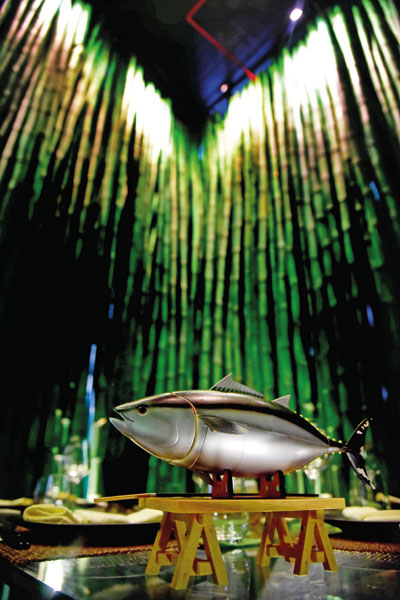More than a name and restaurant
View(s):- As the popular Nihonbashi marks 30 years, the man behind it Dharshan Munidasa reflects on his out of the box journey
By Dilushi Wijesinghe
On July 2, Nihonbashi will introduce its latest culinary concept titled “Sushi Sen,” an interactive menu that invites diners to create their own hand rolls, adding a fresh layer of engagement to the restaurant’s signature Japanese dining experience.
With Sushi Sen, guests can customise each roll by selecting from 10 proteins, 10 vegetables and 10 sauces and more, allowing for 1000 possible combinations. The launch follows Nihonbashi’s 30th anniversary, celebrated on June 24.
From one kitchen to many
Nihonbashi’s journey began in 1995, when a then 24-year-old Dharshan Munidasa opened a restaurant in Galle Face Terrace. Says Dharshan, “The principles of Japanese cuisine kept me grounded to nature, never relying on short routes or the easy way out.”
The self-taught chef says he never attended culinary or hotel school. “I never studied under a chef. I never went to culinary school or to hotel school, so I think the lack of that kept me outside the box, and I thought differently.”
By 2001, the Nihonbashi name had expanded to a 12-seater sushi restaurant at Odel, followed by a 30-seater outlet at Hilton Residencies. Each concept focused on a distinct area of Japanese cuisine. “It was not a copy-paste of Nihonbashi. It was always different genres of Japanese cuisine that were pushed forward. Nihonbashi Odel was mainly a sushi counter. Nihonbashi JAIC (Hilton) was a combination of a sushi counter and tempura,” he explains.
“So doing such things, being able to adapt, gave us the opportunity to make these small restaurants around us,” he adds. “And I think together we did make a statement in Colombo, not only for myself, but for Japanese cuisine as a whole.”
Over the years, Nihonbashi earned a place on Asia’s 50 Best Restaurants list for ten consecutive years. In 2020, Dharshan was awarded the “The Order of the Rising Sun, Gold and Silver Rays” by the Government of Japan in recognition of his efforts to promote Japanese culinary culture around the world.

Nihonbashi’s new home in Port City: Decor with a personal touch by Dharshan Munidasa. Pix by Indika Handuwala
Nihonbashi has since become the foundation for several other restaurants, including the Ministry of Crab, Kaema Sutra, Carne Diem Grill, and The Tuna and The Crab. Each of these restaurants carries elements of its culinary style, even as they move in different directions.
Today, Nihonbashi has three outlets in the Maldives, two in Sri Lanka, and one in Singapore.
A move to Port City
Nihonbashi now operates from its new home in Port City, in a space personally designed by Dharshan. “This restaurant was built without an interior designer. I very strongly felt I could do this on my own. I had the knowledge of the Japanese ingredients of Sri Lanka,” he says.
“This restaurant space is a testament to what amazing construction material we have here,” Dharshan adds.
The space includes eight private dining rooms, each drawing on themes from Japanese culture. Rooms are named Chikurin (Bamboo Forest), Akamatsu (Red Pine), Bonsai, Ikebana, Samurai, Whiskey, Wine and Sake Room. With an outdoor bar named ‘Lost in Translation,’ a custom-built yakitori grill stands out as potentially one of the largest of its kind.

Although the setting is new, the menu continues to highlight familiar favorites. Offerings range from A5 Japanese Wagyu, sushi, sashimi, tempura, teriyaki, and nabe to a wide selection of yakitori, including chef’s original dishes such as olive oil kake tai cha, shirunashi ramen, karapincha tempura, and ten sabi temaki.
One of Dharshan’s earliest culinary inspirations came from Sri Lanka’s own coastal waters. At a time when maguro sashimi was still largely unfamiliar to local diners, he discovered that Amu Kelawalla, when properly handled and stored, could develop the deep red colour and quality of imported tuna. “Finding that tuna here was an amazing moment. That was my biggest inspiration,” he says.
Challenges along the way
In its early years, Nihonbashi largely served the Japanese community in Colombo. “For the first five years of Nihonbashi’s history, we had about 2000 guests per month. So about 65 guests a day,” he says. Of those, only 20 were non-Japanese. “I think, we did real Japanese food, and therefore the Japanese market did like us naturally.”
That dedication to authenticity also drew criticism. “I also had to go through criticism in the past that our food was too authentic. I was also criticised for not serving California roll. And I said that is not Japanese cuisine. I also had to go through issues of not having cut chilli on the side. I said we are a Japanese restaurant. We do not do that. So I am proud to say that we played some role in making Japanese cuisine popular in Sri Lanka.”
Due to high import duties, Dharshan relied heavily on sourcing ingredients locally. He recalls spending hours in local markets, searching for the freshest catch. “Today, having opened restaurants in Singapore and Australia and doing pop-ups in Dubai, we realise those countries do not have many ingredients, and how blessed we are to have these harvests of the oceans and lakes.”
“Every negative factor that I encountered, we overcame and made it a positive one. It is not only a celebration of a restaurant and a name. It is a celebration of who works here today and who have worked for me in the past. And it is a celebration of what this country has to offer. “It’s a privilege to be able to cook for someone. It’s a lot of happiness, if you make someone happy.”
Searching for that next furry family member but couldn’t find one in your area? Hitad.lk has the solution with our extensive listings of dogs for sale in Sri Lanka!


